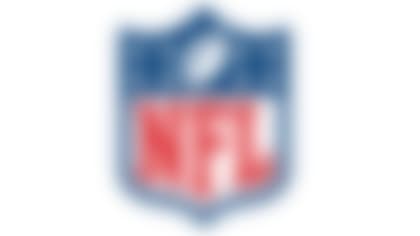I am a fountain of useless information. I'm certain that I've won more than a few bar bets for various friends around the country by answering late night texts about Dexys Midnight Runners and knowing the difference between the Crimson Twins.
For the record, Xamot was the one with the scar.
It actually stems from a mild Google addiction I suffer from. My girlfriend continually mocks my desire to always be right. I prefer to think of it as a desire to have the facts. Regardless, that same information jones got me to wondering about a frequent fantasy trope -- is Year 3 when most fantasy receivers break out?
More specifically, can fantasy owners expect big things from Cecil Shorts and Torrey Smith this season? And what does that mean for fantasy studs like A.J. Green and Julio Jones heading into their third seasons?
Since Shorts and Smith haven't yet reached the ranks of No. 1 fantasy receivers, let's start there. We looked at their production through the first two seasons of their respective careers and compared them to a recent wideout with similar numbers. Maybe the most surprising feature was not only how close the stats were, but how similar the situations of the corresponding receiver was.
Cecil Shorts
The Jaguars' youngster was one of fantasy football's biggest surprises in 2012, coming out of seemingly nowhere to lead the team in receiving yards and receiving touchdowns. He also finished the season second in targets and receptions.
His fantasy doppelgänger? Take your pick between Brandon Lloyd and Roddy White. Like Lloyd, Shorts wasn't an offensive factor in his first season. But both players made their presence felt in a much more significant way in their sophomore campaigns. Both also spent the beginning of their respective careers in woeful offenses with Lloyd languishing in some awful 49er teams. The difference? In Lloyd's third season, he "exploded" for just 48 receptions, 733 yards and five touchdowns. Shorts surpassed all of those numbers with his 2012 season.
Actually, Shorts might be the toughest of the third-year wideouts to forecast. White was a fairly consistent producer in his first two seasons, working his way up from being Atlanta's No. 3 wideout as a rookie to establishing himself as the go-to guy in the passing game by his third season.
It's hard to imagine Shorts seeing the same ultimate destiny with the Jaguars. His cause in 2013 will be helped in part by Justin Blackmon missing the first four games with a suspension, but Blackmon's strong finish to last season portends a future as the Jaguars' star pass-catcher.
The verdict on Shorts? He hasn't hit his ceiling yet, but it seems unlikely that he'll ever reach the level of fantasy stud -- especially if the Jaguars don't do anything to upgrade their quarterback situation.
Torrey Smith
When it comes to fantasy introductions, Smith had one of the most memorable of all time. Three of his first four NFL catches went for touchdowns as part of a five-catch, 152-yard day. After that, the speedster can be accurately described as consistently inconsistent.
Same could have been said of a young Greg Jennings. Like Smith, who played in the shadow of Anquan Boldin, Jennings was second fiddle to Donald Driver in Green Bay's offense. But it was in the third season that the tide turned and Jennings became the top target in the Packer attack.
That's a fate that Smith will have imposed upon him this season. Now that Boldin has switched bays from Chesapeake to San Francisco, Baltimore's third-year wonder will be asked to shoulder a big load. It's a load that will likely only get heavier now that Dennis Pitta is lost for the season.
So will Torrey Smith emulate Greg Jennings' third season totals (80 rec., 1,292 yards, 9 TDs)? Considering the Ravens' offense is powered by Ray Rice and Boldin was the team's leading receiver in 2012 with 65 catches in 112 targets, it doesn't seem likely. But can Smith top 1,000 yards for the first time in his career? That's certainly a strong possibility.
Okay, so we looked at two up-and-coming WR prospects. But what about a pair of guys who have already earned their fantasy bona fides? In theory a third-year breakout would take them to the heights of the wide receiver position.
Julio Jones
When a team gives up as much as the Falcons did in order to move up in the 2011 NFL draft, the bar is set pretty high. So far, Julio Jones has made Atlanta general manager Thomas Dimitroff look pretty smart. You won't hear many complaints from fantasy owners, either.
But the comparison to Hakeem Nicks is interesting in a couple of respects. Both Nicks and Jones are paired with equally productive receivers (Victor Cruz, Roddy White) that have No. 1 fantasy WR capabilities. The other reason is that injuries have slowed both throughout their careers.
Jones sat out three games in his first season and while he played all 16 in 2012, his name was a staple on the Falcons' weekly injury report. Meanwhile, Nicks has become notoriously injury-prone, missing five games in his first two seasons. In fact, it's probably safe to assume the two wideouts' numbers would be even more similar if Nicks had been healthy for a couple more games.
Need another similarity? Having an equally productive receiver on the other side of the field could work as a cap on each man's producttion. Jones has already bested Nicks' third-year output (76 rec., 1,192 yds, 7 TDs), but the bigger point is that it's hard to imagine the Alabama product getting much better -- at least as long as White is still collecting mail in Atlanta.
A.J. Green
Green has been a fantasy star since he first stepped on an NFL field. From the beginning he's been the go-to receiver in the Bengals' offense and took a pretty big step forward from Year 1 to Year 2.
In that way, he's very much like his fantasy stunt double -- Larry Fitzgerald. As a rookie, Fitzgerald led the Cardinals in receptions, yards and touchdowns. Then he turned it up in his second season and nearly doubled his catches and yards. The only difference is that Fitzgerald had help across the way from Anquan Boldin, who had been drafted the year before.
But there hasn't been much that has slowed Fitzgerald's production throughout his career -- although last season's abysmal QB play in the desert proved that even Fitz has his limits. Similarly, there doesn't appear to be much standing the way of Green being Cincinnati's primary offensive weapon for the foreseeable future. He's built a solid rapport with Andy Dalton in a passing game seeking a productive No. 2 receiver and the Bengals are still trying to find a consistent running game. In Year 3, 100 receptions and 1,500 yards aren't out of the question for Green.
All in all, looking for big progressions from fantasy receivers in their third year might be asking too much in some cases, but expecting improvement shouldn't be ridiculous. Just call it a case of wanting to have the facts.
Marcas Grant is a fantasy editor for NFL.com and a *Jeopardy! champion in his own mind. Follow him on Twitter @MarcasG.*



